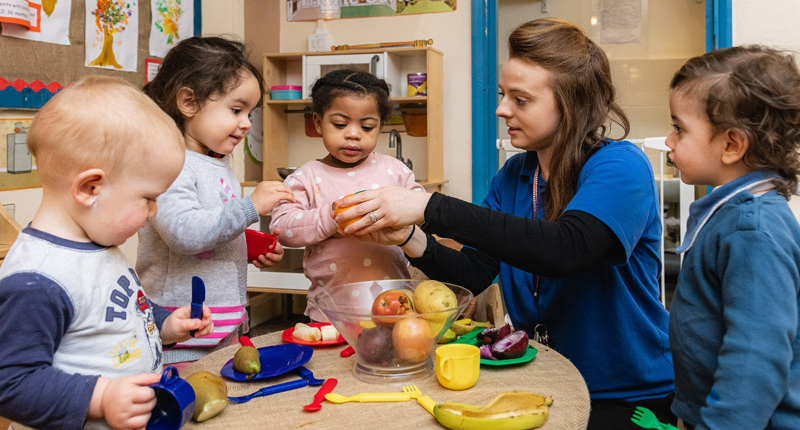Latest News & Information

Latest News & Information

Treetops Nursery
Our nursery & pre-school in Willesden, NW10, offers high quality childcare for babies & children aged up to 5 years. We’re also near Harlesden, Kensal Green, Willesden Green, NW2 and NW6.
Latest News
Contact Us
Treetops Nursery
Doyle Gardens
Willesden
London NW10 3SQ
020 8963 1259


Bird Feeder Activity for Kids
With any of these feeders, though, don’t expect birds to come right away. They’ll be suspicious of anything new in the garden for a while, so children need to be patient while the birds learn to trust the new addition. Once they have accepted it, though, they’ll come again and again if suitable food continues to be supplied.
Apple Feeders
Pine Cone Feeders
If no pine cone is available, the same approach can be used but using a chunk or thick slice of bread instead of the pine cone. However, we do not recommend it as bread will go mouldy if left outside for more than a day or two, and this can harm or even kill birds.
Suet* Flower Pot Seed Cakes
Suet or lard can also be used to make flower pot seed cakes. However, this will require the help of an adult because it will need to be …
Bee-Friendly Flower Growing for Kids
Sourcing Bee-Friendly Seeds
Even easier are …
How to Attract Garden Wildlife – for Under-5s
Attracting Mini-Beasts, Insects & Reptiles to the Garden
Mini-beasts like woodlice, centipedes, millipedes and many other bugs will love it if children leave them an undisturbed compost area to nest in. Insects and even reptiles like lizards and slow-worms may even move in. All they need is composting vegetation like rotting leaves, logs and perhaps grass cuttings that gradually break down — and they’re happy!
Hedgehog Hotels
On a side note, milk is harmful to hedgehogs, so never put it out in the garden for them.
Insect Houses & Bug Hotels
If children have no garden, simply attach an insect house (also known as a bug hotel) to …
15 Baby Facts That May Surprise You
1. One Born Every Minute?
That’s not even close! Did you know that a baby is born, somewhere in the world, every 3 seconds? That equates to 28,800 new babies coming into the world every single day and over 10½ million new babies every year.
2. Babies Favour September
3. Short People Live Longer
Another study suggests that shorter people live longer than taller people, on average. With females being statistically shorter than males, it makes sense, then, that male babies will have lower life expectancies than females.
4. Foetuses have Gills, Fur & a Tail
While they’re foetuses, babies have fur, a tail and gills at certain stages of their development. The gills are slits found in the neck, called pharyngeal arches. These eventually develop into ear and jaw bones before the baby is born. Meanwhile, the tail becomes the child’s coccyx. In regard to having fur, some babies will lose theirs by the time they are born but others may shed it within the first few weeks following birth.
5. A Unique Smile
6. Amazing Brain Growth
Just in the first year, babies’ brains will grow to twice the size, going on to triple from their birth size by the time the child reaches the age of …
Childcare Grants for UK Students
Today, we’ll take you through the rules around eligibility for the childcare grant and explain how much is available.
Eligibility Rules for Student Parents
A few rules also apply in relation to the childcare provider that receives the funding:
How Much Do You Get?
The Childcare Grant for students is worth up to …
16 Ways Nature Benefits Children
1. Nature is Good for the Mind & Spirit
2. Imagination Stimulation
Nature stimulates the creative mind in children. The natural world is a place of absolute wonder, when you think about it — particularly for the very young. So, spending time outdoors sets their minds working to create adventures, build, perhaps draw, create dens, collect flowers, invent games and so much more. Nature is an almost limitless source for children’s imaginations!
3. Nature Gives Children Perspective
4. Nature Promotes Profound Thinking
Children also get to think bigger thoughts and ask bigger questions when they spend time out in nature. For example, “Where do I fit into the world?” … “What is this little creature doing?” … “What is he or she thinking?” … “How do those little seeds grow in the wild?” … “What is life?” … “How did we all get here?” … “Where does planet Earth fit into the bigger picture?” … and so on.
5. Nature Gives Children Greater Freedom
The natural world is vast so, with suitable adult supervision, allows children to …
EYFS Early Learning Goals for Under-5s
The Purpose of the Early Learning Goals
The Early Learning Goals (‘ELGs’) are used as a way for early learning practitioners and childcare professionals to continually gauge the progress of each child’s learning and development. Specifically, they’re used as incremental benchmarks to help ensure that children are successfully heading towards ‘school readiness’ by the time they leave early years settings around the age of 5. This is the point when they move to Reception Year at primary school.
Children are assessed continually against Early Learning Goals that are appropriate for their age. A ‘Key Person’ assigned to each child is a critical part of this. The assessment allows the Key Person and other childcare professionals to tailor the individual learning and development programme so that it is customised to the strengths, interests and any weaknesses of each child.
Parents/carers are also kept informed at all stages and are indeed encouraged to continue helping their child towards the same goals when at home. This tandem approach has been shown to have enormous benefits for the child, both in the short and long term.
Furthermore, if a special educational need is identified during assessment, families and childcare practitioners can then …
Should I Send My Child to Nursery?
What is a Good Nursery?
The Benefits of a Good Nursery or Pre-school
Now we’ve established what a good nursery/pre-school is, what did the 2020 DfE study say about sending under-fives to one? Well, they found that there are both short-term and long-term benefits to children if they …